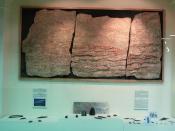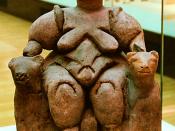Economic Patterns:
The community's economy was apparently based on agriculture, along with a developing practice of cattle raising. Also it is the first established city to have employed the exchange of goods with distant regions. The first ornamented pottery, metal works and large animal grazing was undertaken here. With established methods of agriculture, the people of Catal Hoyuk grew three types of wheat and barley as well as many other varieties of grain and cereal. It is also known that they produced oils of maize, wheat and peanut.
Social & Political Organization:
Catal Huyuk was a primary source of Western civilization, a nexus of trade and ideas for two thousand years, the first organized cosmopolitan city-state and arguably the source of the Great Mother Goddess religion.
Religion & Values:
Catal Hoyuk's houses with their wall paintings, bulls' heads and statues clearly indicate that the local people had obvious beliefs and acts of worship.
Despite profuse religious motifs, there does not appear to be any signs of offerings or sacrifices. There are no suggestions that any animals were sacrificed or any pits were made for the storing of sacrificial blood.
Catal Huyuk has yielded among other splendors, a unique sequence of sanctuaries and shrines, decorated with wall paintings, reliefs in plaster, animal heads, and containing statues, which give us a vivid picture of Neolithic man's concern with religion and beliefs. Of the discovered paintings, most display religious concerns. In all the homes the religious paintings and statues have the heads of animals with horns. Some houses have peculiar differences to them; for example, small areas found are considered to be areas of worship. According to current thinking, when an important member of a house died, the house was emptied and closed. When the house was opened at a later date...


